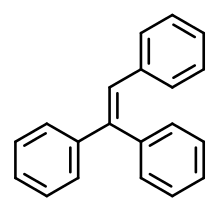Triphenylethylene
Triphenylethylene (TPE) is a simple aromatic hydrocarbon that possesses weak estrogenic activity.[1][2] Its estrogenic effects were discovered in 1937.[3] TPE was derived from structural modification of the more potent estrogen diethylstilbestrol, which is a member of the stilbestrol group of nonsteroidal estrogens.[4]
 | |
| Identifiers | |
|---|---|
IUPAC name
| |
| CAS Number | |
| PubChem CID | |
| ChemSpider | |
| CompTox Dashboard (EPA) | |
| ECHA InfoCard | 100.000.359 |
| Chemical and physical data | |
| Formula | C20H16 |
| Molar mass | 256.34104 g/mol g·mol−1 |
| 3D model (JSmol) | |
SMILES
| |
InChI
| |
TPE is the parent compound of a group of nonsteroidal estrogen receptor ligands.[1][2][5] It includes the estrogens chlorotrianisene, estrobin (DBE), triphenylbromoethylene, triphenylchloroethylene, triphenyliodoethylene, triphenylmethylethylene; the selective estrogen receptor modulators (SERMs) afimoxifene, brilanestrant, broparestrol, clomifene, clomifenoxide, droloxifene, endoxifen, etacstil, fispemifene, idoxifene, miproxifene, miproxifene phosphate, nafoxidine, ospemifene, panomifene, and toremifene. The antiestrogen ethamoxytriphetol (MER-25) is also closely related, but is technically not a derivative of TPE and is instead a triphenylethanol derivative. The tamoxifen metabolite and aromatase inhibitor norendoxifen is also a TPE derivative. In addition to their estrogenic activity, various TPE derivatives like tamoxifen and clomifene have been found to act as protein kinase C inhibitors.[6]
See also
- List of SERMs
- Benzothiophene – parent compound for another group of nonsteroidal SERMs that includes raloxifene
- Phenanthrene – parent compound of steroidal estrogens like estradiol
- Chrysene – parent compound of a group of nonsteroidal weak estrogens that includes 2,8-DHHHC and tetrahydrochrysene
- Doisynolic acid – parent compound of a group of nonsteroidal estrogens that includes doisynoestrol
- Allenolic acid – parent compound of a group of nonsteroidal estrogens that includes methallenestril
References
- JORDAN V. CRAIG; B.J.A. Furr (5 February 2010). Hormone Therapy in Breast and Prostate Cancer. Springer Science & Business Media. pp. 95–. ISBN 978-1-59259-152-7.
- Philipp Y. Maximov; Russell E. McDaniel; V. Craig Jordan (23 July 2013). Tamoxifen: Pioneering Medicine in Breast Cancer. Springer Science & Business Media. pp. 4–. ISBN 978-3-0348-0664-0.
- Jie Jack Li (3 April 2009). Triumph of the Heart: The Story of Statins. Oxford University Press, USA. pp. 33–. ISBN 978-0-19-532357-3.
- Carmen Avendano; J. Carlos Menendez (11 June 2015). Medicinal Chemistry of Anticancer Drugs. Elsevier Science. pp. 87–. ISBN 978-0-444-62667-7.
- Antonio Cano; Joacquim Calaf i Alsina; Jose Luis Duenas-Diez (22 September 2006). Selective Estrogen Receptor Modulators: A New Brand of Multitarget Drugs. Springer Science & Business Media. pp. 52–. ISBN 978-3-540-34742-2.
- O'Brian CA, Liskamp RM, Solomon DH, Weinstein IB (1986). "Triphenylethylenes: a new class of protein kinase C inhibitors". J. Natl. Cancer Inst. 76 (6): 1243–6. doi:10.1093/jnci/76.6.1243. PMID 3458960.